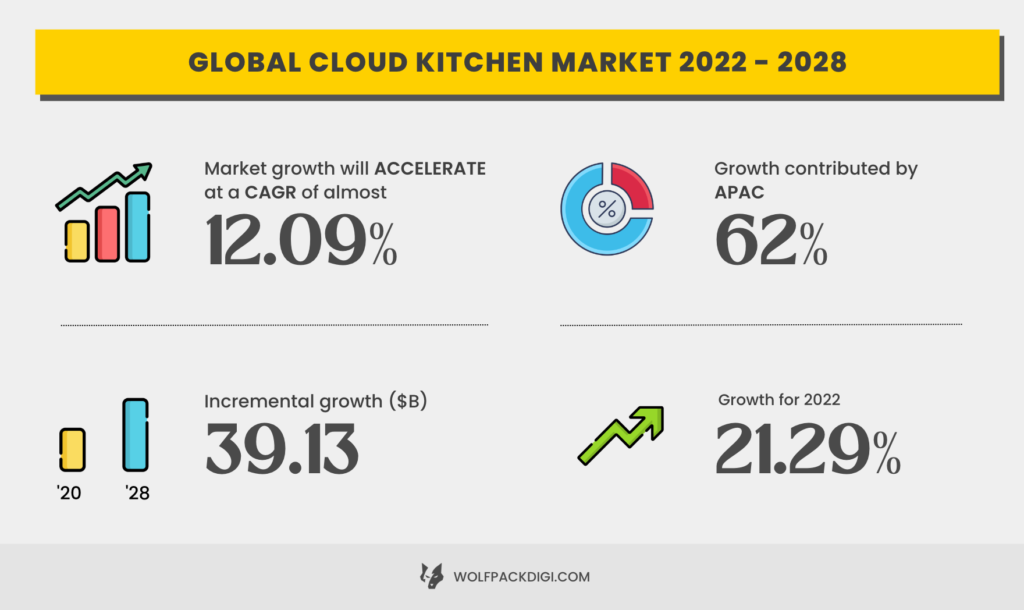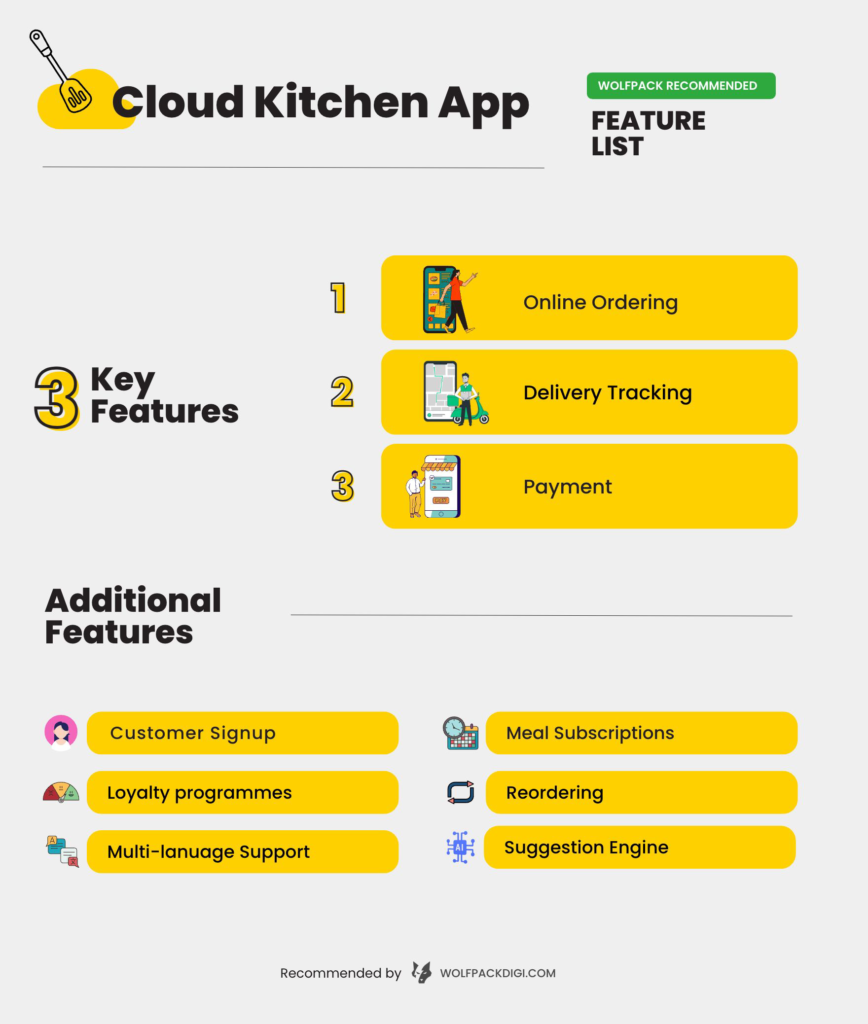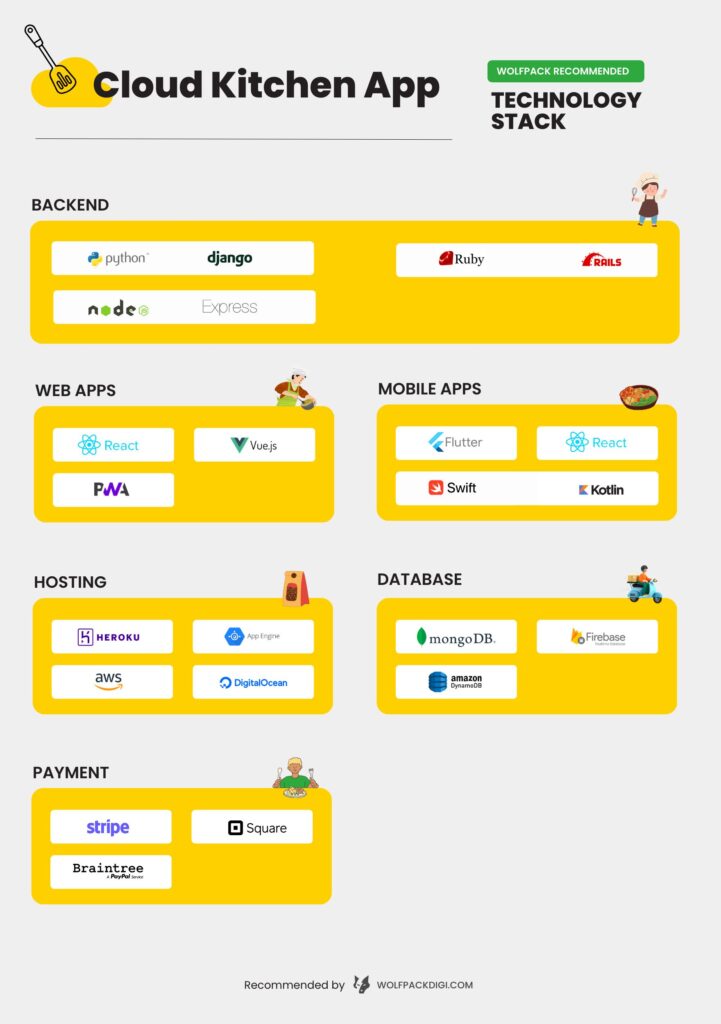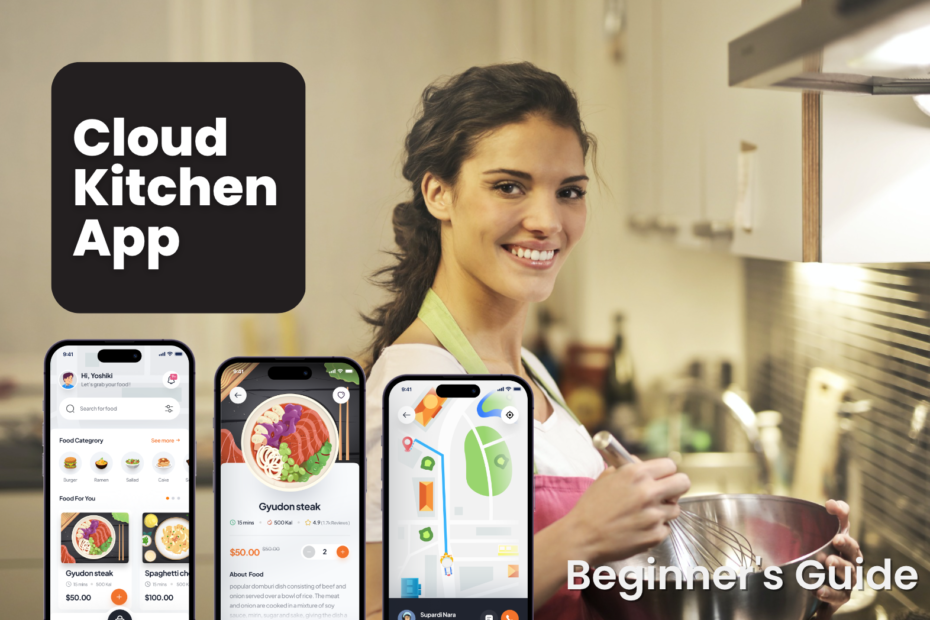The food industry is constantly evolving, and one of the latest trends is the rise of cloud kitchens. Also known as virtual kitchens or ghost kitchens, these are restaurant concepts that operate solely through online ordering and delivery services. By eliminating the need for physical dining space, cloud kitchens can save on overhead costs and increase efficiency. This concept boomed during the ongoing pandemic where dine-in options have been limited and the demand for food delivery has skyrocketed. Although the pandemic came to a halt, the business of cloud kitchens kept on booming.
Cloud kitchens are essentially commercial kitchens that are used to prepare food for delivery only. They don’t have a dining area and customers can order food through online platforms or mobile apps. This business model allows restaurant owners to save on rent and other fixed costs associated with maintaining a physical location. Additionally, it also allows them to reach a larger customer base as they can deliver food to a wider area.
As the demand for food delivery continues to grow, the popularity of cloud kitchens is also on the rise. In fact, according to a report by ResearchAndMarkets, the global cloud kitchen market is expected to reach $118.5 Bn by 2027, growing at a CAGR of approximately 13% during the forecasted period.

Some of the top players in the cloud kitchen industry include UberEats, Grubhub, DoorDash, and Deliveroo. These companies not only provide delivery services for cloud kitchen restaurants but also offer tools and resources for restaurant owners to set up and operate virtual kitchens. Additionally, many established restaurant chains are also jumping on the cloud kitchen bandwagon, with brands such as KFC, McDonald’s, and Starbucks experimenting with virtual concepts.
Another popular trend in the cloud kitchen industry is standalone cloud kitchens, also known as virtual restaurants. These are restaurants that operate exclusively online and have no physical storefront. Standalone cloud kitchens often have a specific niche or theme, such as a certain cuisine or dietary restriction. Some examples of successful standalone cloud kitchens include “The Vegan Joint” in Los Angeles, which pampers its consumers with vegan cuisine, and “Korean BBQ To Go” in New York City, which specializes in traditional Korean barbecue dishes. Another example of a successful standalone cloud kitchen is Masalabox in India, which specializes in Indian street food and has built a loyal customer base through its online presence. By focusing on a specific niche, standalone cloud kitchens can target a specific market and build a strong brand identity. This approach can be a cost-effective way to start a restaurant business and reach a wider audience.
With the market for cloud kitchens on the rise, now may be the perfect time for entrepreneurs to consider starting their own virtual kitchen business. In the following sections, we will discuss the planning and development process for creating a successful cloud kitchen app that caters to the needs of all stakeholders (owner, consumer, and delivery partners).
Planning your cloud kitchen app
Before diving into the development of your cloud kitchen app, it’s essential to have a clear understanding of your target audience and their specific needs. This will help you identify the key features that your app should have to provide the best experience for your customers.
You may perform market research to find out who your target market is and collect information on their demographics, geography, income, and purchase patterns. Online surveys and social media platforms are other tools you may utilize to learn more about your target market. Furthermore, you may hold focus groups and interviews to better understand their requirements, preferences, and expectations from a cloud kitchen software.
You may utilize this knowledge to pinpoint the essential features that your app needs after you have a firm grasp on your target market. For instance, you could want to concentrate on features like quick and simple ordering, real-time delivery tracking, and connection with well-liked payment methods if your target audience is mostly busy working professionals. However, if your target market is mostly youngsters, you might want to concentrate on features like discounts, loyalty programmes, and tailored offers.
Three Primary Features
Online ordering, delivery tracking, and payment integration are some of the most crucial elements of cloud kitchen software. Customers that use online ordering can do so without calling or going to the restaurant by placing their orders straight through the app. Customers may follow their orders through delivery tracking, which offers ease and transparency. Customers may pay for their items immediately through the app with payment integration, eliminating the need to manage cash or credit cards.
1. Online Ordering
One of the most crucial functions of a cloud kitchen software is online ordering, which enables clients to make their orders through the app without calling or going to the restaurant. With the ability to see menu items, adjust orders, and make special requests, this feature needs to be simple to use, intuitive to navigate, and user-friendly. To meet the demands of all clients, it should also be optimized for both mobile and online platforms. Additionally, the functionality should allow for one-click ordering for recurring customers and choices to preserve customers’ past order information.
2. Delivery Tracking
Another essential feature of a cloud kitchen app is delivery tracking, which enables users to follow their orders in real time and offers ease and transparency. Customers should be able to follow the status of their orders from the moment they are placed if this feature is connected with the one that allows for order placing. Additionally, it has to give real-time information on the status of the order, the anticipated delivery date, and any potential delays. The ability to follow the delivery executive’s position and anticipated arrival time should also be available.
3. Payment Integration
Payment integration is a key component of cloud kitchen software since it allows users to pay for orders straight from the app without having to deal with cash or credit cards. This function must be safe and adhere to all applicable payment requirements. The ability to utilise several payment methods, including credit/debit cards, net banking, and digital wallets, should be available. It should also offer choices to preserve the customer’s payment information for use in subsequent transactions. In order to facilitate group orders, the app should also provide the ability to divide payments among several consumers. For example, popular payment gateway options include Stripe, PayPal, and Square. It should also offer choices to preserve the customer’s payment information for use in subsequent transactions. In order to facilitate group orders, the app should also provide the ability to divide payments among several consumers. Other examples of payment integration gateways include Authorize.net, Braintree, and 2Checkout.

Additional Features
In addition to the three primary features mentioned above, there are other features that can be added to a cloud kitchen app to enhance the customer experience.
1. Customer account creation and login
This enables users to use the app, place orders, and modify their account information.
2. Subscription-based meals
Customers may use this option to sign up for a meal plan, where they can pick from a selection of meals that have already been pre-selected and are delivered to them on a regular basis. Customers searching for a quick and easy method to get meals without having to go through the ordering procedure each time may find this option very helpful. Restaurant businesses have a great chance to boost revenue and client retention by offering subscription-based meals. HelloFresh offers a meal subscription service where customers can choose from a variety of meal plans and have the ingredients and recipes delivered to their door on a weekly basis. This subscription-based model allows customers to have access to a variety of meals each week, without the need to go to the store or plan out their meals in advance.
3. Loyalty Programme
A loyalty programme can be integrated with a cloud kitchen app as another function. Customers are rewarded for their repeat business with this feature, which incentivizes them to keep using the app. Various strategies may be used to create loyalty programmes, like awarding points for each order, offering discounts on subsequent purchases, or granting free meals after a particular amount of purchases.
4. Reordering
This feature allows the consumers to reorder their previous orders without browsing through the menus all over again- all helping them to save time. This feature works best if the target audience is corporate personnel and students.
5. Multi-Language Support
In a diverse and multilingual country like India, Australia, etc, it is pertinent to have a multi-language support system in your apps which makes it more user-friendly- making the potential consumer base of a business much larger. One example of a standalone cloud kitchen company that uses multi-language support in its apps is Foodpanda. Foodpanda offers its service in multiple countries, and as a result, they have integrated multi-language support in its mobile apps and website, allowing customers to navigate and place orders in their preferred language. This feature makes it more convenient for non-native speakers to use the service and also caters to a diverse customer base.
6. Suggestion Engine
The incorporation of a meal suggestion engine is another feature that may be added to a cloud kitchen software. This tool suggests meals to consumers based on their prior orders, nutritional needs, and preferences using machine learning algorithms. This function not only enhances the dining experience for patrons but also aids restaurant owners in boosting earnings. One example of a standalone cloud kitchen company that uses a meal suggestion engine is Zomato. Zomato has developed a meal recommendation algorithm that suggests dishes to customers based on their past orders, search history, and dietary preferences.
7. Subscription-based meals
Customers can sign up for a recurring meal plan, selecting from pre-chosen meals delivered at regular intervals. This offers a convenient option for busy individuals and families who want to save time on meal planning and grocery shopping. Learn more about building a meal subscription app!
In summary, online ordering, delivery tracking, and payment integration are some of the most important features for a cloud kitchen app. They should be user-friendly, intuitive and secure, providing customers with a seamless and convenient ordering experience. Additionally, they should be integrated with other features of the app, such as inventory management and kitchen automation, to provide a holistic solution for cloud kitchen operations.
Researching the best technology and tools to use for app development
In addition to the features discussed earlier, it’s also important to research the best technology and tools to use for app development. Choosing the right technology stack for your app can have a significant impact on its performance and scalability.
Let’s talk about the tools behind the system of your cloud kitchen in detail
1. Backend
There are several backend technologies that can be used to build a cloud kitchen app, including Node.js and Express.js, Ruby on Rails, Python and Django, and Firebase.
Node.js and Express.js are well-suited for building fast and scalable web applications and have a large developer community. Grubhub, a popular food delivery app, uses Node.js and Express.js on their backend.
Ruby on Rails is a popular web application framework that is easy to get started with and Deliveroo, a popular food delivery app, uses Ruby on Rails on their backend.
Python and Django, another popular choice, is known for its convention-over-configuration approach and Zomato, a popular restaurant discovery and food delivery app, uses Python and Django on their backend.
Firebase, a mobile and web application development platform, provides real-time databases, authentication, and hosting, and Swiggy, a popular food delivery app, uses Firebase for these services, although additional work would be required to implement complete functionality for a cloud kitchen app.
Ultimately, the choice of technology will depend on your specific requirements and the skill set of your development team.
2. Web Apps (Frontend)
When it comes to building the front end of a cloud kitchen web app, there are a number of technologies that can be used. React.js, AngularJS, and Vue.js are all popular choices among cloud kitchen companies.
React.js is a JavaScript library that allows for the creation of reusable UI components and efficient management of application state and is utilized by companies such as UberEats, Deliveroo, and Grubhub.
Vue.js is another JavaScript framework that offers a simple and easy-to-learn API for building reusable UI components and handling application state and is used by companies like DoorDash.
AngularJS is a JavaScript framework that uses a declarative approach for building user interfaces and provides powerful tools for complex web apps, and is used by companies such as Zomato and Swiggy.
3. Databases
When it comes to choosing a database for a cloud kitchen app, there are a few options that are particularly well-suited for this type of application. MongoDB is a popular NoSQL database that is designed for scalability and performance. Its document-based data model allows for a flexible and dynamic schema, making it a good fit for cloud kitchen apps that need to handle a large amount of data and frequent changes.
Another straightforward choice for a cloud kitchen app is Firebase Realtime Database, which also features a built-in connection with Firebase Authentication and Firebase Cloud Firestore. A fully managed NoSQL database service, Amazon DynamoDB offers quick and reliable performance along with seamless scaling. It is made for mission-critical, web-scale applications and supports both document and key-value data types. It’s an excellent option for cloud kitchen applications that need to manage a lot of data and have high-performance needs. The ideal database to employ for a cloud kitchen app will ultimately rely on the app’s unique demands, the volume and complexity of the data, and the app’s scalability and performance requirements.
4. Mobile Apps
When it comes to integrating mobile apps into a cloud kitchen system, there are two main options to consider: native app development and cross-platform app development.
Building distinct apps for iOS and Android using their respective programming languages—Swift for iOS and Java/Kotlin for Android—is known as native app development. This method enables the development of programmes that are best in class in terms of performance and user interface on each individual platform. However, it might take longer and be more expensive if there is a different development team for each platform.
On the other hand, cross-platform app development entails leveraging a single codebase to create apps that can operate on many platforms. Due to the ability to reuse the same codebase across many platforms, this method enables quicker development and lower expenses. React Native and Flutter are two well-liked cross-platform app development frameworks. Facebook’s React Native platform enables the creation of mobile apps using JavaScript and React.js. The Dart programming language is used by Google’s Flutter to create applications. Both frameworks offer a comprehensive selection of tools and elements that make it simple to develop beautiful and responsive apps. Cross-platform apps, however, do not always function as well as native apps, and they could only have access to a limited number of platform-specific features..
In summary, both native and cross-platform app development have their own set of advantages and disadvantages. Native app development provides the best performance and user experience, but it can be more costly and time-consuming. Cross-platform app development allows for faster development and reduced costs, but may not always perform as well as native apps. The best approach for a cloud kitchen app would depend on the specific requirements and budget of the project.
In case the business has a lesser budget and cannot afford to develop a holistic application for themselves, they can go developing a PWA. Progressive Web App (PWA) is a cost-effective and easy-to-maintain alternative to native mobile apps for cloud kitchen startups. PWAs can be accessed through web browsers on mobile devices, eliminating the need for installation through app stores. They offer offline support, push notifications, and faster load times, providing a similar experience to native mobile apps. PWAs can be updated and improved over time as the company’s budget and resources allow. They can be created using Vue.js, Angular.js, Angular.js and many others.
If you want to develop a PWA for your own virtual restaurant, you can check out our website for further
Get ahead of the game with cutting-edge Progressive Web Apps technology for your virtual restaurant. Enjoy a faster, smarter and more reliable online dining experience for your customers. Partner with wolfpack for a customized solution to enhance your restaurant business today.
5. Hosting
There are several hosting options available for a startup cloud kitchen app.
- Platform as a Service (PaaS) providers, such as Heroku, Google App Engine, and AWS Elastic Beanstalk, offer a complete platform for building, deploying, and scaling web applications. This option is cost-effective and simple to use, making it a good fit for cloud kitchen apps that don’t require a lot of custom configurations.
- Cloud hosting providers such as Amazon Web Services (AWS), Microsoft Azure, and Google Cloud Platform (GCP) provide more flexible and powerful options but require more technical knowledge to set up and maintain.
- Container hosting platforms like Docker or Kubernetes are also a good option for efficient use of resources and better scalability, but also require more technical expertise. It is important to evaluate the specific requirements of the app and the technical expertise of the team before choosing a hosting option.

Ready to Scale up?
For cloud kitchen businesses, scaling up is essential since it guarantees that the software can manage the rise in orders and consumers as the company expands. Without adequate scalability, the software may become sluggish or crash, degrading user experience and perhaps costing the company money.
By employing a microservices design to divide the software into smaller, more manageable components, enhancing app performance, and tracking app usage data, scaling up entails automating the process of adding extra servers and resources. Cloud kitchen startups can manage rising traffic and demand, enhance the customer experience, and ultimately succeed in business by putting these principles into practice.
Scaling for a startup cloud kitchen app involves preparing for increased traffic and demand by automating the process of adding new resources, using a microservices architecture to break down the app into smaller components, optimizing for performance, and monitoring app performance and usage metrics to identify areas for improvement.
When it was first established in 2017, Cooking United just had one kitchen space in Pasadena, California. Since then, it has grown to have other sites all around the country. Restaurant owners, food trucks, and meal kit providers offer shared commercial cooking areas. They have also created technologies to help their clients buy online, get deliveries, and eat outside the restaurant. Kitchen United has been able to offer adaptable, affordable solutions for food companies wishing to broaden their customer base and income streams by scaling up their operations.
Marketing for your Virtual Restaurants
Marketing is important for cloud kitchens because it helps to increase the visibility and awareness of the brand, attract new customers, and generate repeat business. Without effective marketing, a cloud kitchen may struggle to stand out in a crowded market and may not be able to grow its customer base as quickly.
Some of the marketing strategies for a cloud kitchen could be:
- Influencer Marketing: Partnering with popular food bloggers or social media influencers in the area to promote the cloud kitchen’s menu items and special deals. For example, a cloud kitchen could collaborate with a well-known food blogger to feature their dishes on the blogger’s Instagram story, reaching a large audience of potential customers.
- Community Involvement: Hosting events or partnering with local organizations to give back to the community and build a positive reputation. For example, a cloud kitchen could host a charity event where a portion of proceeds from sales go to a local non-profit organization, or partner with a local school to provide healthy meal options for students.
- Referral Marketing: Encouraging existing customers to refer their friends and family to your cloud kitchen can be an effective way to acquire new customers at a low cost. For example, a cloud kitchen startup could offer existing customers a free meal or a discount for every new customer they refer.
Development Time and Costs
A variety of variables, like the complexity of the app’s functionality, the number of platforms it will be built for (such as iOS, Android, and the web), and the size and expertise of the development team, might affect the precise development time and cost of a cloud kitchen application. For one platform (iOS or Android), the development of a simple cloud kitchen app with a constrained set of capabilities might take somewhere between three and six months and cost between $30,000 and $60,000. However, creating apps that are more complicated or that target several platforms may take longer and cost more money.
The quotations above are industry average which has been found out via research and observation. If you are looking to build a virtual restaurant for your own, you can also seek out to Wolfpack- in which we will help you develop your first MVP within 3 months. The development cost at Wolfpack goes around $10,000 which is significantly lesser than the industry standards.
Costs associated with marketing and hosting will also rely on a variety of elements, including the size and breadth of the marketing campaign and the hosting package chosen. For between $10,000 and $20,000, a new cloud kitchen app might run a basic marketing campaign that uses strategies like social media advertising, influencer marketing, and email marketing. Depending on the hosting package chosen, charges will vary, but on average a startup cloud kitchen app can anticipate hosting expenditures of between $100 and $1000 per month.
Summary
In order to succeed in the expanding cloud kitchen industry, developing a cloud kitchen software needs rigorous preparation and research. A cloud kitchen app may satisfy the demands of both consumers and kitchen operators if it is designed properly and includes user-friendly features like an easy ordering procedure and effective delivery choices. The success of the app can also be greatly influenced by the implementation of scalable solutions, good payment integration, and successful marketing methods. Cloud kitchen software has the potential to succeed in this developing sector with the correct strategy.
